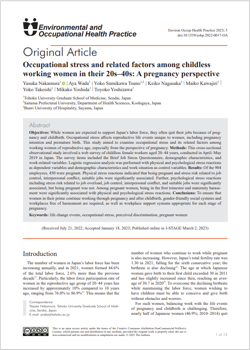#E0061 The Importance of a Stress-Free Workplace Environment to Encourage Pregnancy Intention

The Importance of a Stress-Free Workplace Environment to Encourage Pregnancy Intention
The Japanese government has been robustly supporting women’s active participation in the labor force. Over the last 18 years, legislation and policies have focused on gender balance—transforming women’s social conditions, while inveigling men to assume childrearing duties. Women now represent a respectable 44.6% of the total labor force, while paternal leave has risen to 7.48% in 14 years. However, the willingness of women to deal with work–life balance while pregnant is declining, similar to the fertility and birth rates.
These researchers suggest one reason women are reluctant to work while pregnant could be due to occupational stress experienced in the workplace. Accordingly, they surveyed 904 women aged 20–44 years using a 57-item Brief Job Stress Questionnaire (BJSQ), which individually measured physical and psychological stress. Some 21.6% of the women were non-pregnant, whereas 92.0% were pregnant. The BJSQ is highly recommended by the Ministry of Health, Labour and Welfare and widely used among researchers in Japan. Notable data from respondents are that most were married (56.6%) and most (58%) worked for more than 40 hours a week. Approximately 16% were professionals and just under 50% were clerical/civil servants.
The results of the two-month survey showcased diverse physical and psychological stress reactions. The study defied expectations and showed participants at high risk for physical and psychological stress. Physical stress risk factors for pregnant women were job control, interpersonal conflict, and job suitability. Correspondingly, high risks of psychological stress reactions stemmed from job overload, job control, interpersonal conflict, and job suitability. Pregnant women were not only exposed to these variables but were also subject to maternity harassment in their first trimester. This can be disconcerting given that most miscarriages occur during this period.
The efforts of the government to support women’s retention in the labor force are noteworthy. Evidently, legislation will continue to be amended to promote work–life balance for women. Companies will also need to make greater efforts to provide ongoing support for female employees. This is in light of inferences of low implementation because of workplace cultures. Nevertheless, a calming workplace environment will reduce occupational stress among pregnant women and also delay retirement postpartum.

Link to the original journal article:
https://www.jstage.jst.go.jp/article/eohp/5/1/5_2022-0017-OA/_article
Title of the paper:
Occupational stress and related factors among childless working women in their 20s–40s: A pregnancy perspective
Authors:
Yasuka Nakamura, Aya Wada, Yoko Sumikawa Tsuno, Keiko Nagasaka, Maiko Kawajiri, Yoko Takeishi, Mikako Yoshida, Toyoko Yoshiz




